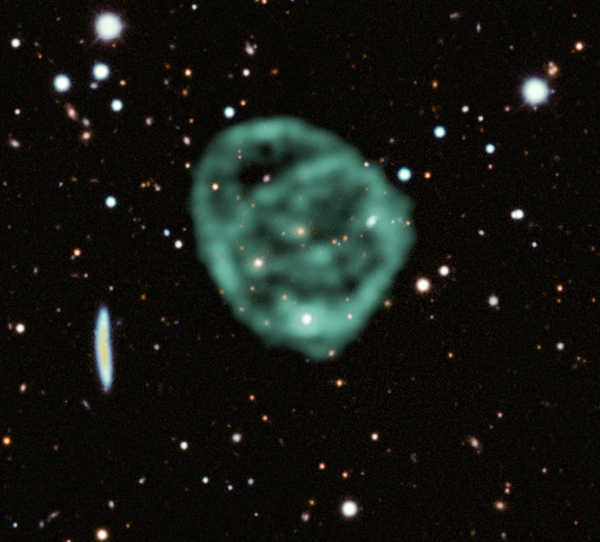Astronomers recently uncovered strange radio objects lurking in the deep sky that take on a rather ghostly appearance. The hazy, circular blotches are unlike anything seen before, which is why scientists have dubbed them odd radio circles, or ORCs.
First discovered in 2019 using the Australian Square Kilometre Array Pathfinder (ASKAP) radio telescope, the mysterious objects seem to be rare: The current tally of known ORCs sits at five. But despite the limited sample size, researchers have been able to learn that ORCs, which only seem to emit light at radio wavelengths, reside far beyond our galaxy. They are also anything but small. At about 1 million light-years across, ORCs are roughly 10 times wider than our Milky Way.
In an attempt to learn more about the anatomy of ORCs, scientists recently targeted one with the South African Radio Astronomy Observatory’s MeerKAT radio telescope. “ASKAP and MeerKAT is a great combination,” Ray Norris, a professor at Western Sydney University and lead author of the new study, tells Astronomy. “One does the finding, the other the deep studying.”
MeerKAT’s deeper view of the ORC revealed the circle’s complex internal structure, which consists of multiple arcs. And while the exact origin of the ORC remains a mystery, the new observation provides important constraints for models.
The new study was published March 24 in Monthly Notices of the Royal Astronomical Society.
How do ORCs form?
The new radio observations also revealed a tiny dot in the very center of the nebulous ORC. That small source, which also pops out in images taken at other wavelengths, is a galaxy. Although not confirmed, scientists are fairly certain that this is the galaxy responsible for giving birth to the ORC.
Modeling of the ORC’s radio emissions also showed that the structure is nearly spherical. It only appears slightly ring-shaped because there is more material along our line of sight at the ORC’s edges. Moreover, thanks to the MeerKAT observations, scientists were able to reconstruct the magnetic fields within the object. As it turns out, those fields run along the ring’s edges, as if a shock wave had compressed the expanding ORC.
Taken together, these findings have led astronomers to suspect that something happened to the ORC’s central galaxy about a billion years ago, causing it to send out a powerful shock wave through the tenuous intergalactic medium that surrounds it. As electrons wind around the magnetic fields threading through space, they emit radio waves, producing the shiny ring we see today.
“The image fidelity and its details really allow [us] to rule out a number of possibilities for the interpretation of these objects, which could not be ruled out before,” Tiziana Venturi, director of the Radio Astronomy Institute in Italy, tells Astronomy. Venturi was not involved in the new study, but she was part of the team that discovered the first ORCs.
Because the history of the central galaxy seems to be the key unraveling the origin story of ORCs, the authors have come up with three plausible scenarios — though the list is not necessarily exhaustive.
First, a collision between two supermassive black holes inside the galaxy could have produced energetic shock waves. Such collisions have never been observed before, but theory predicts that the most hefty supermassive black holes grew via mergers of smaller black holes. “If that is what it turned out to be, that would be an important way of estimating the rates at which the supermassive black holes merge,” says Norris.
Alternatively, the galaxy might have experienced a period of intense star formation. Energetic newborn stars, as well as exploding dying stars, would push away gas and particles in the form of galactic wind, resulting in an expanding shock wave.
The third option is that astronomers might be looking down the barrel of a jetted outflow from the active core of the galaxy.
Although the team has carefully modeled the star formation scenario, they still need to work out the details for the other two options. Next, they plan to zoom in on the ORCs central galaxy to search for evidence of a past violent merger, which will help them assess the galaxy’s star-formation history.
However, none of the three scenarios can explain the ORCs complex internal structure, though Norris suspects it is the result of interactions between the shock wave and nearby galaxies.
More ORCs Coming
“Of course, explaining a new class of objects based on one object is difficult,” says Venturi. That’s why increasing the sample size is crucial.
In the meantime, the team is currently investigating a couple more possible ORCs that they found in the ASKAP data. Furthermore, they have already used MeerKAT to target several other ORCs, for which they are now processing the data.
More ORCs are also likely hidden in data from other radio telescopes with enormous fields of view, like the Giant Metrewave Radio Telescope (GMRT) in India and the Low Frequency Array (LOFAR) in the Netherlands. In addition to collecting more observations, scientists are also developing machine learning algorithms to make searching for the faint blobs in vast radio images even easier. However, so far, human eyes are still superior at finding ORCs.
Both MeerKAT and ASKAP are two precursor facilities to the Square Kilometer Array (SKA), which will be the largest and most powerful radio telescope in the world. Experience tells us that a novel telescope that probes the universe unlike anything before it should uncover new and unexpected things. That axiom certainly held for the discovery of ORCs. “I thought it would be very hard to find [the unexpected], and I was totally wrong,” says Norris. “I was just eyeballing the ASKAP data, and there were these things.”
With that in mind, there’s no telling what other strange cosmic creatures SKA might uncover.












